Why (and how) I write a personal welcome email for each customer
I automate everything. If I have to do something more than a couple of times, I'll start itching to write a script or app or website that will take away the repetition and let me focus on what I do best as a human.
A welcome email is very easy to automate without thinking. If you use any kind of SAAS or account management framework it will probably have some kind of welcome or confirmation email bundled. You might never even change the defaults.
But that welcome email is our first and best chance to make a good impression on a new customer.
It's the very last thing you should automate.
I'll take you through my journey from thoughtless automation conscientious personalisation. I'll tell you what I learned as a built a sequence of email and CRM tools over the last two years as a solopreneur.
I'll show you four different approaches. The first was too automatic and the last was too manual, but the third is working very well.
And I'll tell you the mad story of how this helped me go from making $193 in a week to making $2,716 in one week, less than two months later.
While I was on vacation.
This post is me expanding on a comment I made here.
Approach 1: Fully automatic nurture sequence
In my first attempt , I was focused on executing a lead magnet, email capture and nurture sequence after seeing this talk: What to Write So People Buy: Selling Your Game Without Feeling Sleazy.
I didn't want to pay for MailChimp so I hacked together an auto-mailer on my Rails site. I sent emails via Amazon SES and had to figure out all manner of confusing SPF, DKIM and DMARC configurations to avoid getting immediately flagged as spam. I put together some rudimentary tracking and reporting to give myself an overview of who was opening what.
I created an automatic nurture sequence that I could interrupt with product announcements. People would get one email per week, offset by the time they signed up, so I just needed to write a few messages to establish my brand and introduce my product. Announcements could be timely but for the nurture sequence I was doing things like dynamically switching commentary "this new feature" to "this feature", depending on how far it was after the feature launched.
I was very much in a code-first, content-second mindset, as evidenced by the fact I had to do a full Heroku deployment every time I added a new message. These would often involve styling and template functionality updates along with the prose.
It was hard to keep my technical bug-fixing brain separate from my emotional/empathic writing brain.
The way I wrote the emails week-by-week made my narrative fairly chaotic and I never felt like returning to anything I'd written so that's how it stayed.
Here's an example of one of those emails:
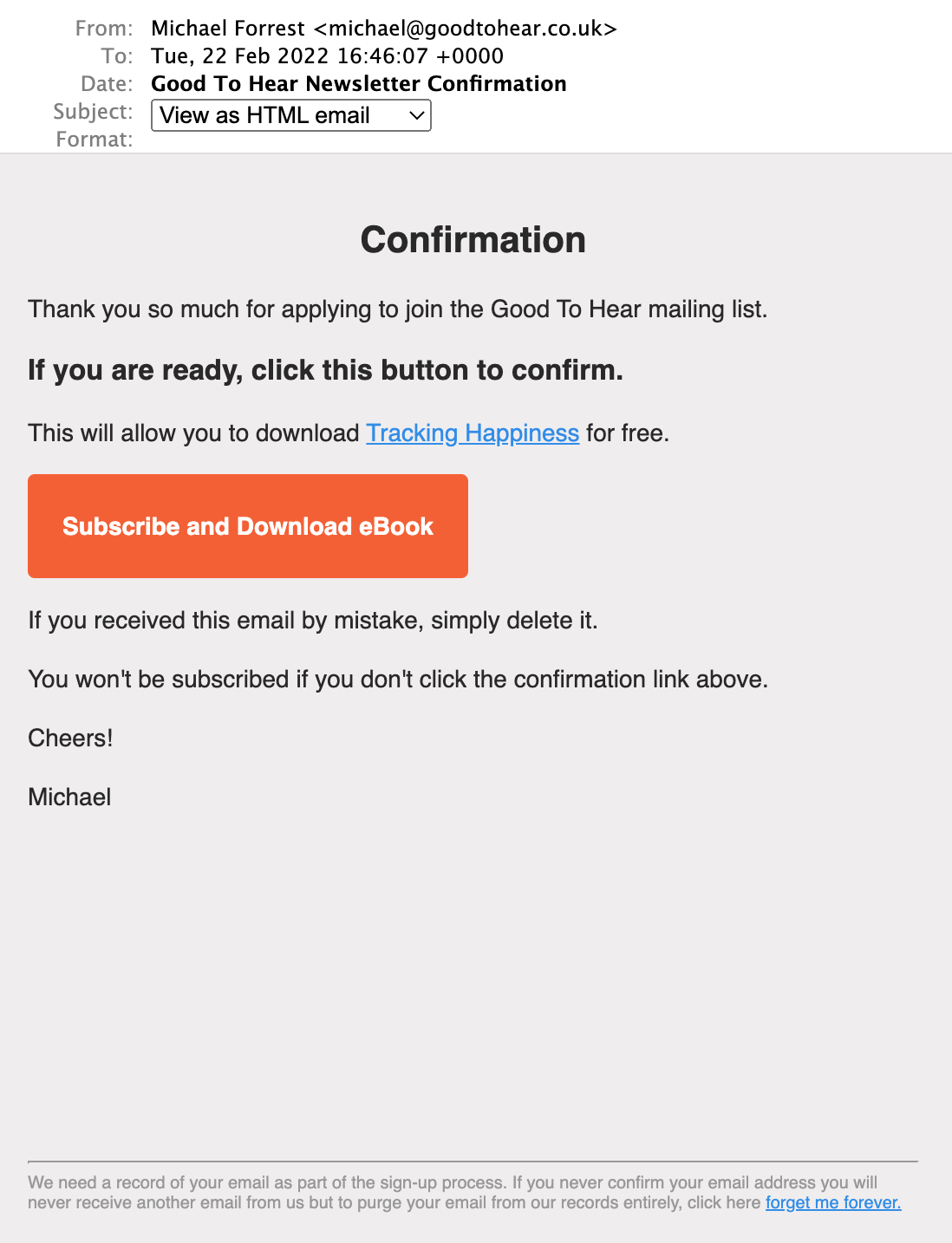
What did I learn from Approach 1?
- People will hand over their email for a good PDF
- Instagram advertising works if you have a nice picture (I had maybe a 25% conversion rate)
- Don't put content under source control if you don't want to wait five minutes to fix an errant comma
- Make it easy to review your email sequence if you roll your own system (I didn't)
The biggest problem was that I did not learn a single thing about anyone who signed up. The subject matter (mood tracking) was so deeply personal and private that I was afraid of what people might say if I asked too much.
This should have been a huge red flag but I still thought that focusing on design and implementation was more important than talking to people.
Approach 2: Semi-automatic
The second platform I built was a time management tool with an audience, apparently, of one 😅. I'm embarrassed to say that I had such high hopes for the site that implemented a waiting list / referral mechanic before I launched.
This time I built in Phoenix and the sign-up process was required to use the platform rather than being a simple newsletter form. I integrated pow to handle user accounts but, honestly, I found myself fighting with it the whole time. It was so awkward to customise templates and behaviour that I didn't attempt to change the default emails until months after launch.
After reading about the importance of clear onboarding I added a whole introduction layer into the platform which uses a welcome email to show users what to expect and guides them through the steps I want them to learn to use it, and sends reminder emails.

I was not prepared for the effort it takes to make an email look good. I never really got it perfect (I wish I'd discovered premailex sooner - it converts css classes into inline styles).
I didn't know what my nurture sequence would be for this platform (I still don't) so I built myself an admin tool that let me filter users by their sign-up date and activity, with a browser form to write and preview my Markdown templates.

It was pretty crude but I was able to try out ideas much more quickly than before.
What did I learn from Approach 2?
- Email needs to be tightly integrated with your site UX, not an afterthought
- BCC is a really easy way to keep an eye on things (I BCC myself into every email my server sends)
- Attempting to style HTML emails is a losing battle unless you've done it a lot
- Phoenix LiveView is worth learning and I wish I'd learned it before building the whole thing in React / Redux.
A huge mistake
I had a customer - somebody I didn't know - who paid £54.99 and I didn't even send them a message.
I had made no time to find out anything about my visitors and as a result I spent my whole time building something that only really worked for me.
I was still in a code and features mindset, instead of in a people-first mindset.
Approach 3: A healthy(ish) balance
My latest platform, Squares TV, is focused on content, built around the user base that has grown around my webcam app. This is a diverse and fascinating selection of people and I'm spending as much time as I can meeting and learning from them.
Because people use the app in so many different situations, segmentation is a priority. I have a quiz inside the camera app that asks people about what they're doing.

It's a pretty extensive tree but it's all useful context for my first email (if they choose to provide their email).
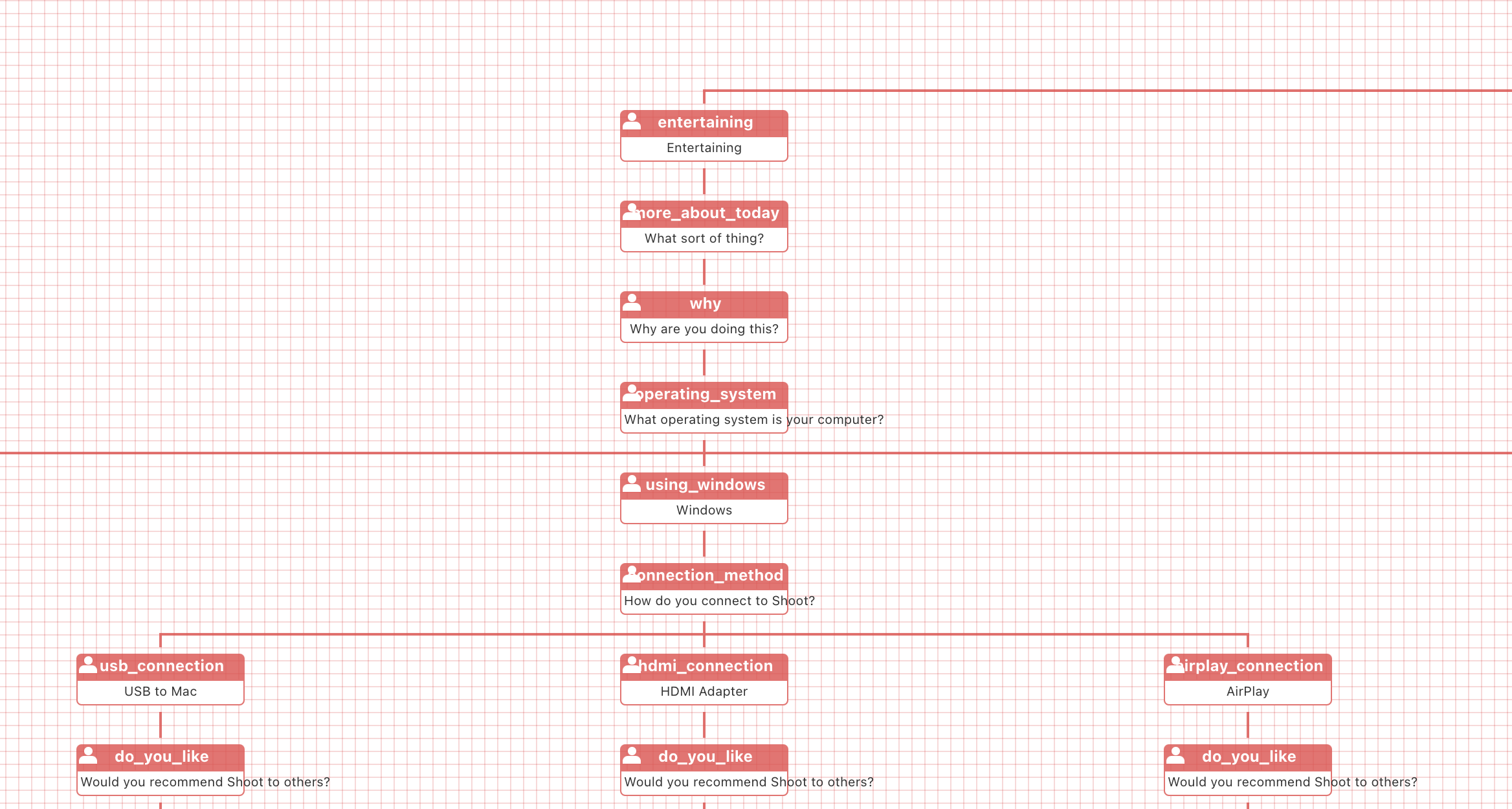
On the site itself I took a much simpler approach and essentially ask people to choose which segment fits them best, with some free text for more information. Usually they're trying to access a tool I've created as a lead magnet.
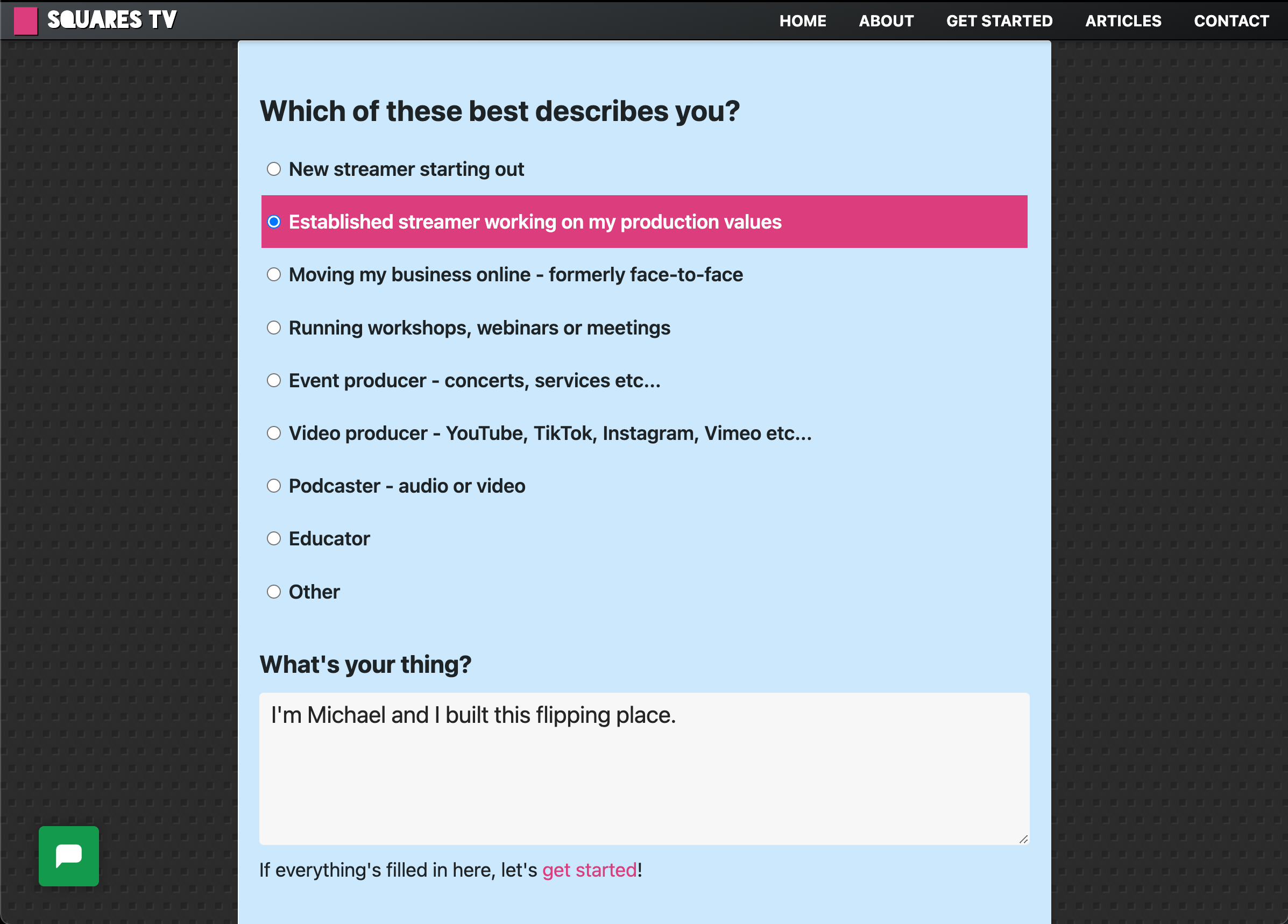
Since my previous attempt I'd found José Valim's post where he proposes the idea that the best authentication framework is no authentication framework at all. This was a huge breakthrough for me, as now I could fine tune every aspect of my email capture sequence without having to fight with a framework every time. So the quiz above appears before the user confirms their email address and then automatically goes to the page they want after they hit confirm in another tab. I didn't want passwords for a mailing list but I let people manage passwords once they use members-only features of the website.
My emailing tool
Here's how I send emails.
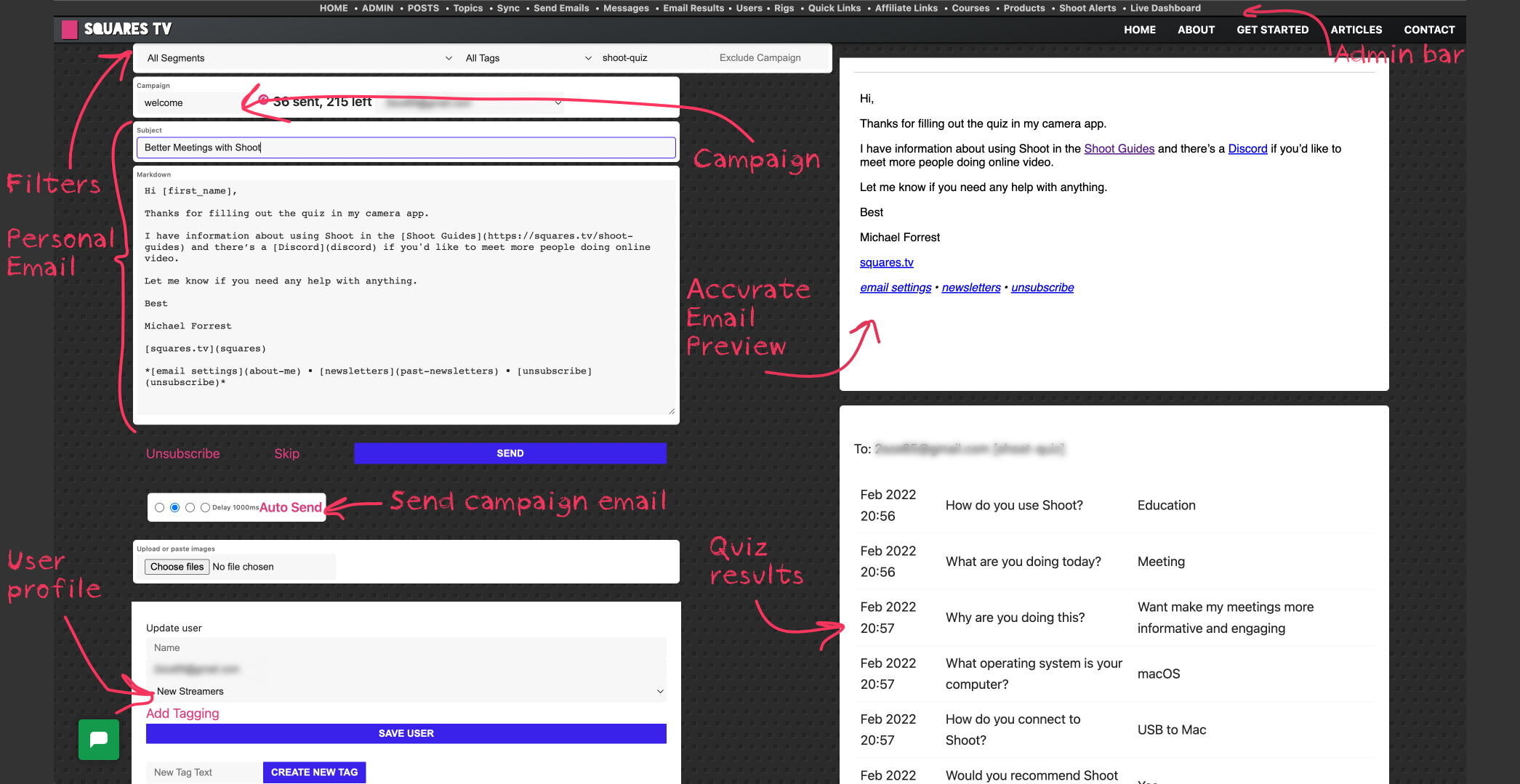
I can filter on a source campaign and then it will show me who to email next. It shows me the information they've given me and I can add extra metadata as needed. Some will come through via the quiz in my app, some through other tools or posts on the website.
I am building up a library of templates in my Notes app and using these as a basis for each new message, tailored to what I know about each user.
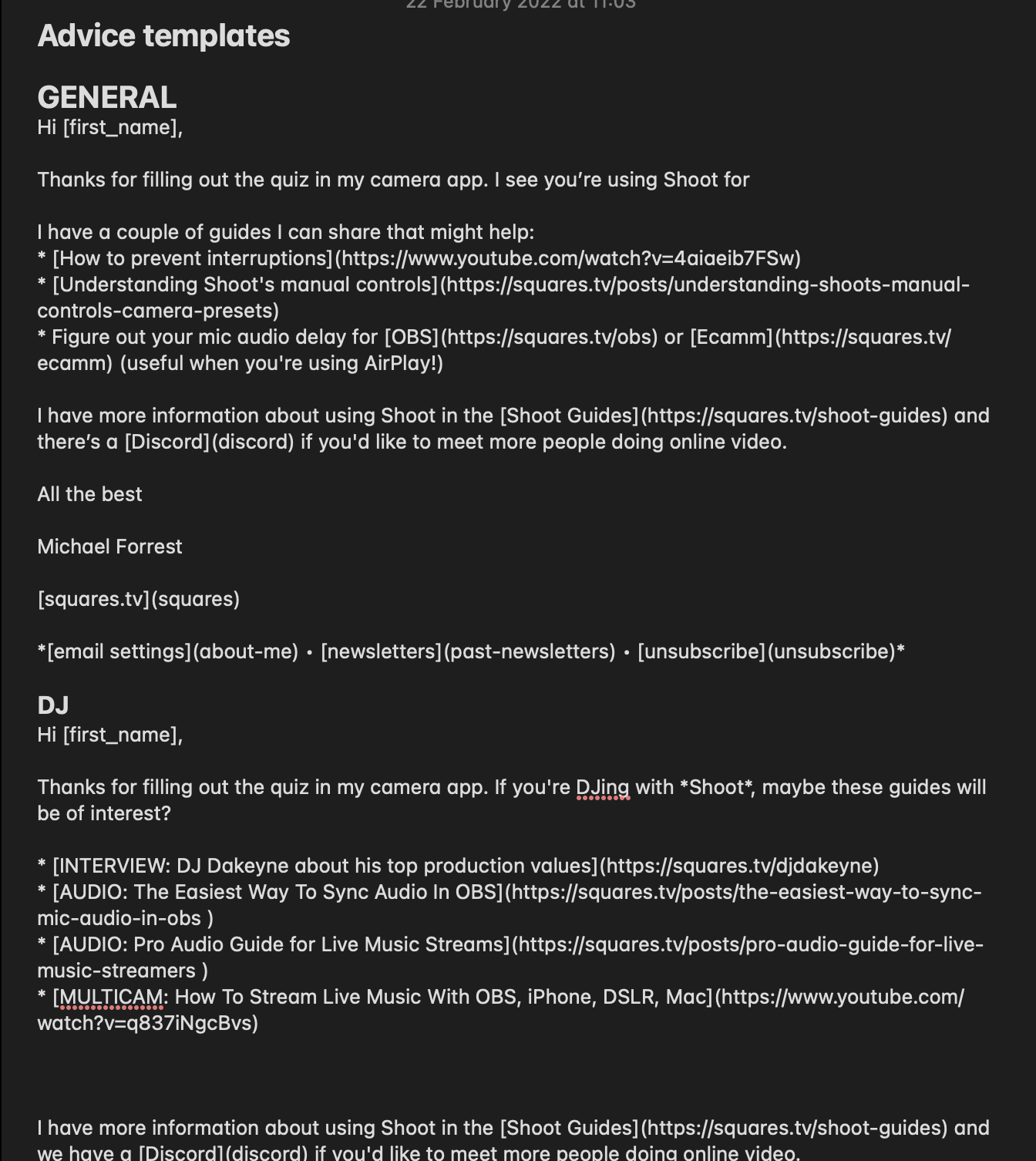
I decided to let these emails look like something that could have come from Gmail instead of some fancy-schmancy MailChimp template because I want people to reply.
What I learned with Approach 3
- People respond well to a plain email
- Asking a few questions automatically makes it much easier to write a personalised welcome email
- Segmentation is hard and takes lots of conversations to untangle
- I want the opportunity to personalise every email my platform sends out
- The best authentication framework is no framework at all
- The more you talk to people, the more you can help them, the more apps you'll sell
Approach 4: No code at all
I recently released a little app I'd made for myself. I'm not allowed to write any code at the moment so I wasn't able to build any fancy Stripe integrations so I had to settle for creating a button and keeping an eye on my inbox.
I've made three sales of this little app and I have been in email contact with all three users. I'm copying their email addresses from the Stripe dashboard into my CRM tool and using this to send them welcome messages and establish them on my mailing list with the correct segmentation.
This is a stop gap as I'm not allowed to write code until March.
A mad success story
- June 2021: I interview a school teacher who uses my app to teach woodwork in a classroom. This gives me the idea to add a "pause" and "virtual whiteboard" feature
- November 2021: I record interview an interview with a Dutch videographer who shoots choir performances in Churches
- December 2021: My partner's father suggests I should interview someone from the Jewish community next. I'm making less than $200 per week on my app sales.
- January 2022: I release a "delay calculator" tool on Squares TV and notice that a Rabbi has signed up to use it. I send a personalised welcome email to him and ask if he'd do an interview. I introduce him to my camera app on our call.
- February 2022: The Rabbi talks about my camera app on a popular AV Tech forum show and the host falls in love with the virtual whiteboard and pause features.
- The host talks about it on a popular podcast and I make $2,700 in one week. While I'm on vacation.
And that's why you focus on people first.
What's next?
I want to automatically pre-populate each email with sensible links and subject lines, but be able to add a personal touch every time before I send. I want to start matching up my library of templates to different segments and keywords.
Will this be complicated to code? Yes. Do I need to do this? Possibly not.
In summary
You can't fully automate human connection, so don't try.
Nobody likes an email from a robot.

what a journey @michaelforrest...though i appreciated so much of what you said here, my favourite parts were the "mad success" stories and your conclusion. "You can't fully automate human connection, so don't try." thanks for this!
thanks @Silvio_SF :)
Can I just say, I took a week off and had a spike in sales and it's been a real slog sending out all these emails this week! I've had something like 30 emails to write and it's been like pushing through treacle getting through them all. I think it's a worthwhile exercise as I discover the various gaps in the support content I need to create but it kinda sucks. 😅
This was an interesting read!
Honestly, I’m perplexed at that fact that you decided to build your own email client instead of just paying for something like mail chimp.
It’s obvious you’re a talented engineer that loves to build! I’m curious if you factor your time as an expense? How much time did you spend building this, and how much value is it adding? Is it greater than the cost of mail chimp?
What do you think the outcome would have been if you invested your time in talking with more customers and shipping more customer focused features?
Hi @ZackHack, I think the short answer is I'm trading off up-front investment against an ongoing expense. While I know I have a "building too much" problem I feel like users - people - are such a critical element of whatever I create that I don't want all their info sitting on somebody else's server. And while a mailing list would be doable on MailChimp, as soon as you build any kind of SAAS you're gonna need to tackle email one way or another.
Since I've been full time on my own business, cashflow has been a constant problem. MailChimp would instantly have become my second biggest expense. I'd be paying a premium for something that didn't quite work how I wanted, and I'd be stuck paying for it indefinitely. $50 a month adds up very quickly (and I don't think that tier even gives you nurture sequences!). I'm especially grateful I rolled my own thing now that it's on the back burner - I can still receive the odd sign-up on an old product and get some low-level benefit of that automation, without paying a lot of money for the privilege.
I've been prioritising talking to customers for about 8 months now and while it was a slow burn to start with, as I fleshed out my vision for Squares TV and Shoot, I'm already seeing the benefits compounding. Compared to two years generally avoiding talking to customers where I saw absolutely no adoption whatsoever.